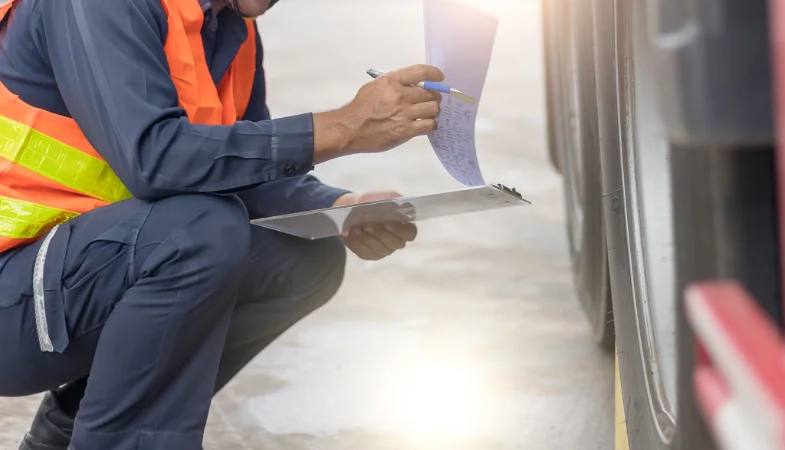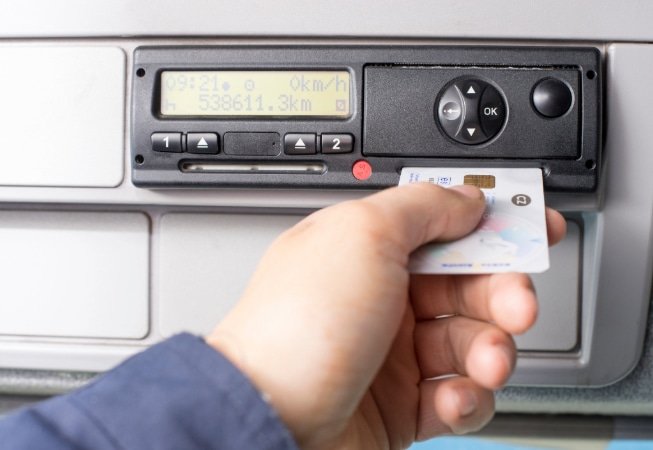The Complete Guide to DVSA Roadworthiness
The DVSA Guide to Maintaining Roadworthiness was produced to explain the responsibilities and systems involved in keeping vehicles in a roadworthy condition, regardless of operating conditions, fleet size, or vehicle type.
The purpose of this guide – updated for DVSA’s April 2025 guidance – is to help transport managers, operators, workshop leads, drivers, and all those who are responsible for operating, maintaining, or providing commercial goods and passenger carrying vehicles, to understand exactly what DVSA expects, how to plan inspections, and how to prove compliance at short notice.
It also shows where digital tools make this simpler, serves as a reminder that operators stay responsible for legal compliance, and summarises official sources and good practice.
DVSA Roadworthiness Requirements
Daily Walk-Around Checks
A driver, or appointed responsible person, must conduct a walk-around check of a vehicle prior to using it on the public highway. A minimum of one walk-around check must be carried out every day, or at least once in every twenty-four-hour period that the vehicle is in service.
There must be a system of reporting and recording defects that may affect the roadworthiness of the vehicle. This must include how they were rectified before the vehicle is used. These reports and records must be kept.
Safety Inspection Intervals
An inspection frequency would normally range between four to thirteen weeks. The DVSA recommends ten to thirteen weeks for lightly loaded vehicles, six to ten weeks for general haulage, four to six weeks for arduous work, and four weeks for off-road vehicles.
Safety inspections should, where practical, be programmed to follow a time-based pattern like above. The frequency at which inspections aer undertaken should be decided by assessing the level of mechanical deterioration likely to be incurred over a period as a result of the vehicle’s duty cycle, mileage, age, and usage.
Older vehicles and trailers will need more frequent maintenance. A minimum safety inspection frequency of six weeks is needed for vehicles and trailers aged twelve years and older, unless operations clearly justify longer.
Record Keeping
Records must be kept for at least fifteen months. This includes:
- Records of safety inspections for all vehicles, including vehicles that have been removed from the operator licence or have been sold or otherwise disposed of
- Drivers’ defect reports used to record any faults and rectification work, including nil returns if you use them
- Brake performance evidence
Driver walk-around checks, safety inspections, first-use inspections, and intermediate safety checks must be documented using either manual paper systems, electronic systems, or a hybrid of both, as long as the records are complete and accessible.

Service vs Safety Inspections
A safety inspection is a periodic inspection that is carried out at pre-set intervals in line with what an operator has declared on the vehicle operator licensing service and checks roadworthiness to at least MOT standard.
An inspection should not be confused with a service, which contains items requiring routine maintenance, usually determined in scope and frequency by the vehicle’s usage and the recommendations of the vehicle’s manufacturer. This is maintenance per manufacturer, and not the same thing as a safety inspection.
First-Use and Intermediate Checks
Before putting any newly acquired vehicle on the road, operators must conduct a first-use inspection to satisfy themselves that it is in a roadworthy condition.
With some types of vehicles and operation, it may be necessary to check some components more often than at full safety inspections, such as where duty is harsh. Any additional intermediate safety checks carried out should be documented and kept on the maintenance file.
It should be clear on the documentation that these are an intermediate safety check and not a full safety inspection.
Electronic Records
Electronic records are acceptable, provided that:
- They are tamper-proof and capable of producing hard copy information if needed
- They are time-stamped, and include secure signatures
- They show a clear audit trail from inspection to sign-off after repair. It is important that it includes a declaration that the vehicle is fit for service or whether repairs are needed
Why Fleet Compliance Matters
The Traffic Commissioners for Great Britain are an independent tribunal with a mission to promote safe, fair, efficient, and reliable passenger and goods transport through effective licensing and regulation of the commercial vehicle industries.
The DVSA and Traffic Commissioners require – under the Goods Vehicles (Licensing of Operators) Act 1995 and the Public Passenger Vehicles Act 1981 – for vehicles to be kept in a fit and serviceable condition through adequate facilities and satisfactory arrangements.
Failure to comply can lead to prohibitions, public inquiries, curtailment, or loss of vocational driving licence or operator’s licence.
What non-compliance looks like:
- Missed or extended preventative maintenance inspections (PMI’s) beyond the stated interval: operational needs must not override safety considerations.
- Insufficient evidence of brake performance over time: it is essential that the system provides braking performance evidence where this is to be used for the safety inspection braking performance report.
- Weak defect reporting and poor rectification records: a robust driver defect reporting system details the initial walk-around check and any defects or ‘nil’ defects reported during the day for the various drivers of that vehicle. Reports must be recorded, and provision should be made to record details of any rectification work done.
- Paper records are incomplete, damaged, or missing: the result is often prohibitions, a negative impact on Operator Compliance Risk Score (OCRS), and audit exposure.
DVSA Guide to Maintaining Roadworthiness Requirements
Daily walk-around checks
A driver, or appointed responsible person, must conduct a walk-around check of a vehicle prior to using it on the public highway. A minimum of one walk-around check must be carried out every day, or at least once in every twenty-four-hour period that the vehicle is in service.
The walk-around check should cover the whole vehicle or combination and include all interior and exterior items that can be safely assessed without the use of a workshop and are visible without dismantling the vehicle.
Drivers should be aware that reporting defects promptly is a critical element of an effective vehicle roadworthiness system. Any defects, or symptoms of defects, that could prevent the safe operation of the vehicle, found during the walk-around check, while the vehicle is in use, or on its return to base, must be the subject of a written report by the driver or some other person responsible for recording defects.
There must be a system of reporting and recording defects that may affect the roadworthiness of the vehicle, which forms part of the vehicle’s maintenance record which must be kept for at least fifteen months, together with details of any assessment, the rectification work, and repairer.
It is good practice to complete and keep ‘nil’ defect reports as they are a useful means of checking that drivers are carrying out their duties and these forms can be used for audit purposes. A ‘nil’ defect reporting system proves a check has been conducted and is a positive report that the vehicle is free from defects. It is recommended that ‘nil’ defect reports are kept for at least three months.
Regular safety inspections
Safety inspections should, where practical, follow a time-based pattern. The frequency at which inspections are undertaken should be decided by assessing the level of mechanical deterioration likely to be incurred over a period because of the vehicle’s usage. An inspection frequency would normally range between four to thirteen weeks. For example, ten to thirteen weeks for lightly loaded vehicles, six to ten weeks for general haulage, four to six weeks for arduous work, four weeks for off-road vehicles, and six weeks for vehicles or trailers that are twelve years old or older.
The DVSA produces annual test inspection manuals, which give details of inspection methods and pass/fail criteria. The standards for the annual test are the minimum legal standards and should be used as guidance for the safety inspection, which should meet or exceed the standard.
A safety inspection report must be completed for each safety inspection for both vehicles and trailers. Each report should show the; name and signature of inspector, location of the inspection, items to be inspected and the condition of each item inspected, details of any defects found, details of any remedial, rectification or repair work and who carried it out, and a signed statement declaring that all safety defects have been repaired satisfactorily and the vehicle is now in a safe and roadworthy condition. Safety inspection reports produced following an inspection not only provide the operator with the means to determine individual vehicle roadworthiness, but also the overall effectiveness of their maintenance systems that then allows them to find areas for review.
First-use and intermediate checks
Prior to using a newly acquired vehicle on the public highway, operators must conduct a first-use inspection to satisfy themselves that the equipment is in a roadworthy condition. In some instances, a first-use inspection is not needed where robust evidence is provided to show that the equipment has been subject to an equivalent safety inspection.
With some types of vehicles and operation, it may be necessary to check some components more often than at full safety inspections. It is sometimes necessary to check high-wear items where operations are harsh, or components that were recently repaired. Any intermediate safety checks carried out should be documented and kept on the maintenance file. It should be clear on the documentation these are intermediate safety checks and not full safety inspections.
Record keeping and retention
Records of defect reports, safety inspections, and repair records, must be kept for at least fifteen months for all vehicles. This includes vehicles that have been removed from the operator licence or have been sold or otherwise disposed of.
Electronic records are acceptable, if they meet the DVSA’s security and audit requirements, and contain the essential information that can be made available for examination.
Service vs Safety Inspection
A safety inspection is a periodic inspection that is carried out at pre-set intervals in line with what an operator has declared on the vehicle operator licensing service, which confirms roadworthiness and mirrors MOT scope.
An inspection should not be confused with a service, which contains items requiring routine maintenance, usually determined in scope and frequency by the vehicle’s usage and the recommendations of the vehicle’s manufacturer to preserve reliability and economy. This is maintenance per manufacturer, and not the same thing as a safety inspection.
You need both safety inspections and services, and the safety inspection cadence must be maintained even if service intervals differ.
How to set the right PMI interval
DVSA’s guidance suggests that an inspection frequency would normally range between four to thirteen weeks. This will depend on factors such as the; age and type of vehicle operated, distance and speeds at which it travels and the journey times, type and range of operations on which it is likely to be engaged, type of terrain and nature of the environment in which it operates or is likely to operate, nature of its load, and the equipment and fittings it carries or supports.
Assessing these factors for each vehicle will, in most cases, enable a time-based programme of inspections to be formulated. It is encouraged to monitor outcomes of inspections and adjust intervals if the level of defects rise. Older vehicles and trailers will need more frequent maintenance, so a minimum safety inspection frequency of six weeks is needed for vehicles and trailers aged twelve years or older. However, depending on usage, the frequency may be extended.
Working examples from DVSA
Operating conditions Typical frequency
Lightly loaded, easy duty 10–13 weeks
General haulage, trunking 6–10 weeks
Arduous duty, constant heavy loads 4–6 weeks
Off-road or very harsh conditions 4 weeks
Vehicle or trailer 12 years+ 6 weeks minimum
Mileage-based inspection programs may be more suitable for some operators, if routes and workloads vary, but will need to be linked to time. If you change your inspection schedule, it is required to update the vehicle operator license, entering into the system the expected maximum equivalent time-frequency of thirteen weeks and ensuring the mixed frequency box is ticked to record that a varied inspection frequency is being used. It is also sensible to continue to monitor outcomes monthly. A maintenance scheduling system, planner, or wall chart should be used to identify inspection dates at least six months in advance. To allow some flexibility in planning safety inspections, it is recommended that the International Organisation for Standardisation (ISO) week numbering system is used. With this system, the safety inspection should be completed within the relevant ISO week it falls.
Brake Performance
To follow best practice and follow legislation, there is an expectation that every safety inspection will include a brake performance assessment using either a roller brake test (RBT), a suitable electronic braking performance monitoring system (EBPMS), or a decelerometer with temperature readings.
Operators must satisfy themselves that the methods used to assess brake performance are sufficient to meet the requirements of Regulation 18 of the Road Vehicles (Construction and Use) Regulations 1986.
Roller Brake Test
Conducting a laden brake test using a calibrated roller brake tester is the most effective method of measuring individual and overall braking performances. A plate brake testing device may also be suitable depending upon the design of the equipment.
Vehicles can be presented for roller brake testing up to fourteen days before the safety inspection date. This allows the operator the flexibility to conduct a laden brake test during normal operational activities without the need to specially load it. In these circumstances, the RBT report needs to be provided to the person conducting the safety inspection. A copy of the RBT report generated must be kept on the vehicle’s maintenance file.
Electronic Braking Performance Monitoring System
If using EBPMS to monitor brake performance, there must be an evaluation of the performance report before every safety inspection by a competent person who can interpret the data. The evaluation must be signed, dated, and attached to the vehicle record together with the performance data report. The evaluation and data report may be a single document.
At present, EBPMS is only available for use on trailers. Trailers fitted with EBPMS would only require a laden brake test if there was insufficient data to produce a report to confirm the correct operation of the system or where work has been carried out on the braking system that may have affected braking performance.
Where EBPMS is not used, it is expected there will be a minimum of four laden brake tests spread evenly across the year. This can include the annual test.
Decelerometer
It is acceptable to use an approved and calibrated decelerometer to measure overall brake performance values for vehicles without trailers or for vehicles that cannot be tested on an RBT. A decelerometer will measure the overall brake performance but it may not identify individual braking issues. Decelerometer cannot be used for testing trailer brake performance.
A decelerometer with temperature readings would be an acceptable means of a performance assessment, where this is done unladen, then refer to acceptable reasons for not carrying out a laden brake assessment.
A temperature check needs to be carried out before and after the decelerometer test to help identify if individual brakes are operational. Final brake temperature readings need to be significantly higher than the first readings to accurately assess the brake performance, with consistent readings taken for each brake across an axle.
Where satisfactory results cannot be achieved, another method to assess the brake performance needs to be used.
Where a satisfactory EBPMS evaluation report is not available or a laden roller brake test is not carried out with the safety inspection, a risk assessment must be completed by a competent person who understands braking systems and components. However, there is an expectation that every attempt must be made to conduct a laden roller brake test.
A signed printout of the brake performance test from either the RBT, EBPMS, or decelerometer should be attached to the related safety inspection record to keep the audit chain intact. If the brake test equipment cannot produce a printout, the test results must be recorded by the inspector on the safety inspection report.
Digital Tools for Compliance
Electronic systems accepted by the DVSA must:
- Be tamper-proof (for example, records cannot be changed later)
- Have a clear end-to-end audit trail
- Be capable of producing hard copy information if needed
- Have a data back-up and disaster recovery system
Include date and time stamping - Be accessible for sufficient delegated people to maintain effective management control in case of staff absence
- Have digital authentication to support driver signatures and secure logins
This applies to driver daily checks, in-service defects, PMIs, brake results, and planners.
Case Example: Preventing a Public Inquiry with Better Systems
Imagine the scenario: a mixed fleet of HGV’s and trailers runs on eight-weekly PMIs. Several of the scheduled inspections slip to week ten. Drivers send photos of vehicle defects by text, which are not linked to jobs. Brake test receipts sit in a drawer instead of being kept with other vehicle records. A roadside check finds a dangerous brake defect on a vehicle, and the operator is issued with a prohibition. A call to public inquiry follows.
What can change:
- PMIs can be re-planned on ISO weeks with six-month visibility.
- Walk-around checks can be moved to a digital template with secure signature and nil returns.
- Defects can flow to jobs automatically, with timestamps, technician notes, and close-out.
- Brake test results can be stored against the correct asset and inspection.
- Outcome: the operator attends with clean audit packs and evidence of a functioning system that aligns with DVSA expectations and supports the case before the Traffic Commissioner.
Free Templates and Resources
Use these to standardise inspections and improve evidence quality:
- DVSA Safety Inspection Record Examples: A safety inspection report must be completed for each safety inspection for both vehicles and trailers. If the safety inspection report is to be stored electronically, then the paper version does not need to be kept. This does not rule out the use of electronic devices in place of paper safety inspection reports.
- Heavy Goods Vehicle (HGV) Safety Inspection Record example
- Public Service Vehicle (PSV) Safety Inspection Record example
- Light Goods Vehicle (LGV) Safety Inspection Record example
- Small Trailer Safety Inspection Record example
- PMI Planner: To allow some flexibility in planning safety inspections, it is recommended that the International Organisation for Standardisation (ISO) week numbering system is used. With this system, the safety inspection should be completed within the relevant ISO week it falls.
- Maintenance Planner example
- Driver Walk-around Checklist: Walk-around checks should cover the whole vehicle or combination and include all interior and exterior items that can be safely assessed without the use of a workshop. Where trailers are changed on multiple occasions, a check should be made on each trailer being used.
- HGV Walk-around Check diagram
PSV Walk-around Check diagram
- HGV Walk-around Check diagram
- Defect to Rectification Log: To prevent vehicles being used in an unroadworthy condition, there must be a robust system or process in place to ensure defects found during the walk-around check or developed during use are recorded and rectified.
- HGV Walk-around Check Defect Report Form example
- PSV Walk-around Check Defect Report Form example
- Brake Evidence Cover Sheet: To follow best practice and comply with legislation, there is an expectation that every safety inspection will include a brake performance assessment using either a roller brake test (RBT), a suitable electronic braking performance monitoring system (EBPMS), or a decelerometer with temperature readings. A signed printout of the brake performance test from either the RBT, plate tester or decelerometer should be attached to the safety inspection record.
Audit Readiness:
What to show on request:
- Maintenance planner showing past and upcoming PMIs: Safety inspections should be planned in advance. An electronic scheduling system can be used to effectively plan maintenance activities for the fleet. Or a simple method of drawing up a programme is to use a year planner or flow chart.
- Complete safety inspections with signatures and declarations: A safety inspection report must be completed for each safety inspection for both vehicles and trailers. Each report should have a named, signed, and dated statement declaring that all safety defects have been repaired satisfactorily and the vehicle is now in a safe and roadworthy condition.
- Driver defect reports including nil returns, plus rectification proof: Any defects found during the daily walk-around check, while the vehicle is in use, or on its return to base, must be the subject of a written report by the driver or some other person responsible for recording defects. The details recorded should include rectification work and the date rectification work was completed. It is also common practice to use a composite form that includes a list of the items checked each day. Where practicable, the system should incorporate ‘nil’ reporting when each driver makes out a report sheet.
- Brake performance records attached to inspections: To follow best practice and comply with legislation, there is an expectation that every safety inspection will include a brake performance assessment using either a roller brake test (RBT), a suitable electronic braking performance monitoring system (EBPMS), or a decelerometer with temperature readings. A signed printout of the brake performance test from either the RBT, plate tester, or decelerometer should be attached to the safety inspection record. If the brake test equipment cannot produce a printout, the test results must be recorded by the inspector on the safety inspection report.
- If using RBT to monitor brake performance, the RBT report needs to be provided to the person conducting the safety inspection. A copy of the RBT report generated must be kept on the vehicle’s maintenance file.
- If using EBPMS to watch brake performance, there must be an evaluation of the performance report before every safety inspection by a competent person who can interpret the data. The evaluation must be signed, dated, and attached to the vehicle record together with the performance data report.
- Maintenance contracts and workshop competence notes where outsourced: It is essential to have a written contract that sets out precise details of vehicles covered, inspection frequency, type of check, and repair policy. Any subcontractors used should be detailed in the contract. The contract must be kept on the operator’s maintenance file and produced on request. You must also make sure the contracted maintenance provider details are up to date on the vehicle operator licensing service.
- Evidence that unroadworthy vehicles are removed from service and signed back when fixed: There must be an internal system to ensure that unroadworthy vehicles are removed from service, with someone responsible for taking vehicles off the road. If you are the operator, you must ensure that someone within your organisation has the authority to decide whether a vehicle is fit for service at all times. That person must be able to decide whether a vehicle needs to be taken out of service and when it can be allowed back on the road after repairs. The transport manager stays legally responsible for vehicle roadworthiness, regardless of whether their activities are delegated.
All of this should be available promptly and kept for at least 15 months.
How Autocheck helps operators stay roadworthy
Driver walk-around checks
Conducting a daily walk-around check is a vital part of a driver’s core role. Drivers are also legally responsible for the condition of their vehicle when in use on the road, and must report any defects, or symptoms of defects, that could prevent the safe operation of the vehicle. Autocheck makes daily walk-around checks and driver defect reporting quick, easy, and fully compliant.
In addition to daily walk-around checks, drivers must monitor the roadworthiness of their vehicle when being driven and be alert to any sign that the vehicle is developing a fault. With Autocheck, drivers can complete inspections or observations directly from their mobile or tablet, with time-stamped records, mandatory photo uploads, real-time defect reporting, and instant roadworthiness confirmation.
Any defects found during the daily walk-around check, while the vehicle is in use, or on its return to base, must be the subject of a written report by the driver or some other person responsible for recording defects. On our Driver Defect App, any defects are flagged immediately and sent to the workshop for action, so issues can be reviewed, assigned, and rectified quickly, keeping repairs on track and vehicles safe, compliant, and ready for the road.
Records of reported defects must be available for fifteen months, along with any record of repair. On our app, every action is logged and stored securely against the vehicle for a complete, easily accessible audit trail for inspections, compliance reviews, and internal checks. The process is simple, clear, and designed to keep your fleet safe, compliant, and on the road without delays.
Inspections & PMI’s
Safety inspections should, where practical, be programmed to follow a time-based pattern. The frequency at which inspections are undertaken should be decided by assessing the level of mechanical deterioration likely to be incurred over a period as a result of the vehicle’s usage.
With Autocheck, you can create fully customisable inspection templates tailored to different vehicle types, set recurring schedules, and assign inspections to technicians with just a few clicks. Every completed inspection automatically generates a professional, branded job card; colour-coded for clarity and stored indefinitely for full compliance and audit readiness.
A safety inspection report must be completed for each safety inspection for both vehicles and trailers. Autocheck keeps every inspection you complete securely stored, fully searchable, and ready to share whenever you need it. Whether you’re preparing for an audit, sending reports to customers, or simply reviewing a vehicle’s history, everything is at your fingertips, with no paperwork and no delays. Inspections automatically link to job records, keeping your maintenance history organised and complete.
DVLA Integration
Autocheck connects directly with the DVLA to automatically pull correct, real-time vehicle information like make, model, engine code, VIN, MOT dates, and tax status from official records, instead of manually entering vehicle and driver details. This helps you streamline compliance, cuts down on admin time, reduces manual entry errors, and keeps your records reliable and up to date.
We also offer instant DVLA driver licence checks, helping you stay ahead of licence expirations, MOT renewals, and tax deadlines, verify endorsements, and ensure drivers are legally fit to drive. Licence checks carry a small cost per search but give you peace of mind and full compliance with operator requirements.
Whether you’re managing a small fleet or hundreds of assets, Autocheck makes it easy to stay organised, reduce errors, and meet your compliance obligations effortlessly. Everything is stored securely, so your records are always clean, current, and ready for audits or roadside inspections.
Audit Trail
To make certain that your vehicle maintenance system is secure, you should consider an audit trail on both the part of the maintenance provider and the operator. Autocheck allows you to store important documents against each vehicle or trailer, such as V5 certifications, tax and insurance documents, service contracts, maintenance histories, and inspection reports.
Everything is securely backed up, searchable, and accessible whenever you need it. Autocheck provides you with an audit trail that is tamper-resistant with time stamps, plus rapid exports for hearings.
Flat-Fee Pricing
Autocheck is built to grow with your business. Our flexible platform handles fleets of all shapes and sizes, without extra costs or complicated upgrades.
- No limits on the number of vehicles, trailers, or users you can add, so cadence is not limited by seat licences
- Segment and filter assets by type, depot, hire status, or custom tags
- Maintain a clear, searchable history of inspections, defects, and repairs
- Stay audit-ready with detailed version histories and digital records
- Your data is safely stored, securely backed up, and accessible whenever you need it
Autocheck gives you the freedom to scale your operations without worrying about system restrictions or hidden fees, making it the smart choice for growing fleets.
Digital Inspection Templates
Autocheck was built to make creating, managing, and completing inspections simple and flexible for any fleet. Whether you’re running weekly driver checks, scheduling six or eight-weekly PMI’s, or completing specialist inspections, Autocheck puts everything you need in one easy-to-use system. Autocheck provides you with unlimited templates – including digital inspection templates aligned to asset type – colour-coded reports, digital sign-off, and a full audit trail, all without extra fees.
Autocheck is a UK hosted platform with 99.9% uptime and frequent backups.
FAQs
Are digital inspection records acceptable to DVSA?
Yes, digital inspection records and other electronic records are acceptable to DVSA, provided that they contain the essential information that can be made available for examination, show a clear audit trail from inspection to sign-off after repair, and are tamper-proof, capable of producing hard copy information if required, and time-stamped. They must remain available for fifteen months.
What’s the difference between a safety inspection and a service?
A safety inspection is a periodic inspection that is carried out at pre-set intervals in line with what an operator has declared on the vehicle operator licensing service (VOL). The scope of the inspection should check roadworthiness to at least MOT standard. A safety inspection should not be confused with a service. A service contains items requiring routine maintenance, usually determined in scope and frequency by the vehicle’s usage and the recommendations of the vehicle’s manufacturer. You still need the safety inspection cadence even if service intervals differ.
How often should I brake-test?
You must be able to show brake performance over time. To follow best practice and comply with legislation, there is an expectation that every safety inspection will include a brake performance assessment using either a roller brake test (RBT), a suitable electronic braking performance monitoring system (EBPMS), or a decelerometer with temperature readings.
Conducting a laden brake test using a calibrated roller brake tester is the most effective method of measuring individual and overall braking performances. At present, EBPMS is only available for use on trailers. Where EBPMS is not used, it is expected there will be a minimum of four laden brake tests spread evenly across the year, which can include the annual test. It is acceptable to use an approved and calibrated decelerometer to measure overall brake performance values for vehicles without trailers or for vehicles that cannot be tested on an RBT.
A signed printout of the brake performance test from either the RBT, plate tester or decelerometer should be attached to the safety inspection record. If the brake test equipment cannot produce a printout, the test results must be recorded by the inspector on the safety inspection report.
Can I change my PMI interval?
Yes, but if you change your inspection schedule, it is sensible to monitor the effect on roadworthiness monthly. If an unacceptable increase in defects were seen, then a change back to the original schedule would be necessary.
Update the vehicle operator licensing service (VOL) when you change the basis. VOL records a time-based frequency for both vehicles and trailers. Therefore, if a mileage-based frequency is adopted, the expected maximum equivalent time-frequency should be entered into the system. Then ensure the mixed frequency box is ticked on VOL to record that a varied inspection frequency is being used. This same process should be used if a mixed time frequency is being used for different vehicles or trailers on the fleet.
Keep evidence that roadworthiness has not suffered and use the International Organisation for Standardisation (ISO) week numbering system, so safety inspections are completed within the relevant ISO week it falls and to prevent creep.





